A comprehensive guide to the African safari scene
African Safari means “long journey” in Swahili. Today, safari enthusiasts can bypass the arduous trekking of yesteryear to reach the depths of the African safari bush within 24 hours of an airport.
So with half a continent at your disposal, where to start? Should it be the endless plains of the Serengeti in Tanzania or the hidden waterways of Okavango in Botswana? Do you prefer to sit and enjoy the spectacle of wildebeest herds sweeping open savannahs? Or are you perhaps the most active guy, dreaming of paddling in front of lazy crocodiles or spinning a pride of lions on foot?
Your safari choice depends partly on wildlife. For most novices, the Big Five are at the top of the wish list – for the uninitiated, i.e., lions, leopards, buffaloes, elephants, and rhinos, so named because they were once considered the most dangerous opponents of the hunter. Many of them boast about all or most of them, but some offer better odds than others. There are also giraffes, zebras, and hippos not to mention fascinating smaller things, ranging from chameleons to beetles, snooks, and hornbills.
The good news is that, at least in general terms about wildlife, you really cannot go wrong. Although each destination has both its specialties and its absentees (no need to look for a springbok in the Serengeti, for example, or cheetahs in Luangwa), the richness and variety of almost every one of them, as well as the splendor from the African background, obliged to carry you away.
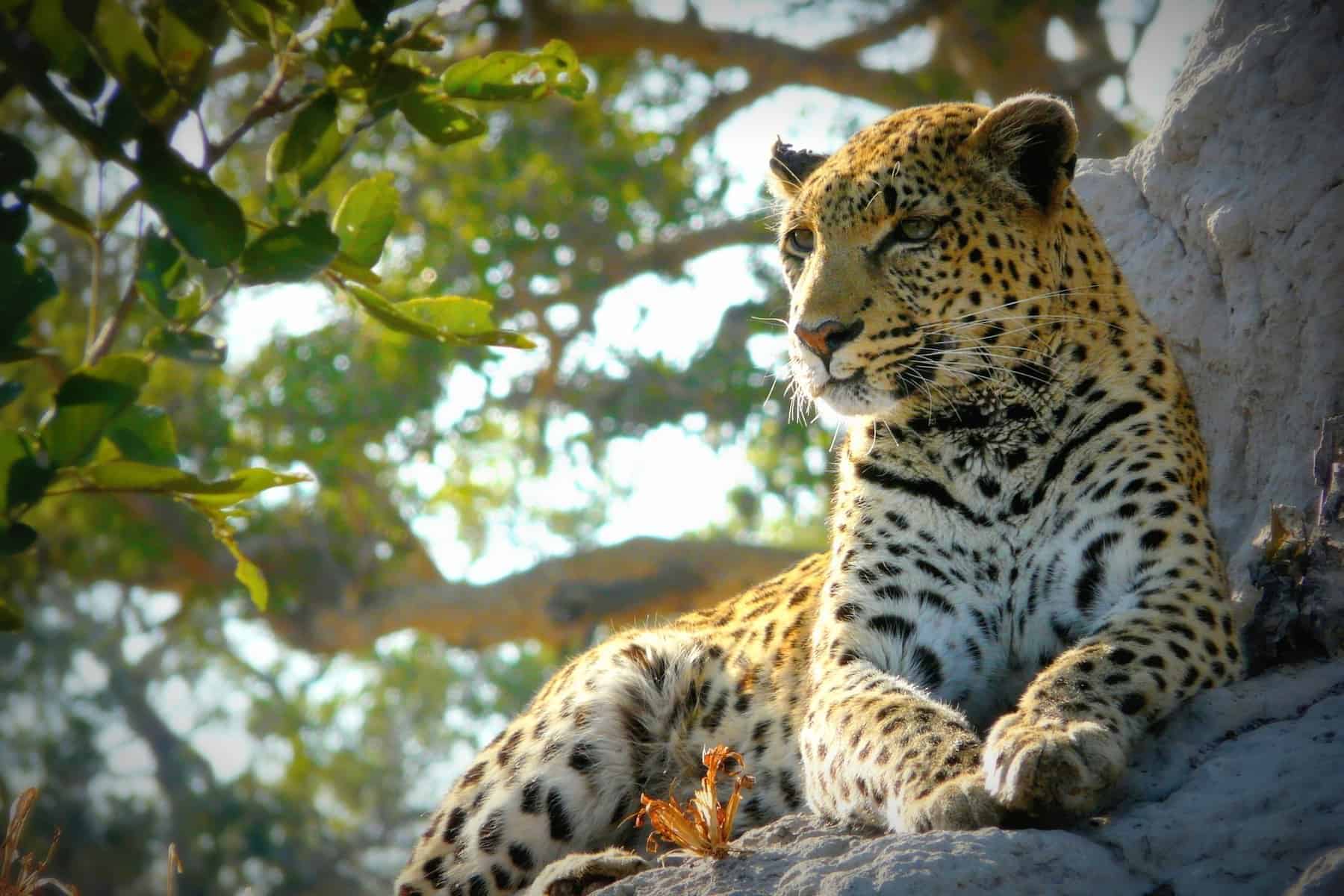
African Safari. A lonely female leopard waits quietly over a hill looking for her prey in Pom-Pom Island private game reserve, Okavango delta.
Go to your favorite African safari spot or read all about safaris
These links take you directly to the place in this comprehensive introduction to Safaris in Africa.
African safari options for first-timers:
- Masai Mara, Kenya
- Serengeti National Park and Ngorongoro Crater
- Kruger National Park, South Africa
- Chobe National Park and Moremi Game Reserve in Botswana
- South Luangwa National Park, Zambia
- Etosha National Park, Namibia
African safari suitable for those seeking more safari adventures:
- Mana Pools and Lower Zambezi National Park, Zimbabwe/Zambia
- Okavango Private Reserves, Botswana and the big 5
- Laikipia Plateau, Kenya
- Imfolozi Wilderness Trails, South Africa
- Ruaha National Park, Southern Tanzania
- Queen Elizabeth National Park, Uganda
African safari for the experienced safari traveler:
- Northern Damaraland, Namibia
- Katavi National Park, Tanzania
- North Luangwa, Zambia
- Central Kalahari Game Reserve, Botswana
- South Selous Game Reserve, Tanzania
- Liuwa Plain, Zambia
The best African safari for first-timers
These safaris bring you directly to Africa’s most famous wildlife, including most Big Five, and do not need to break your piggy bank.
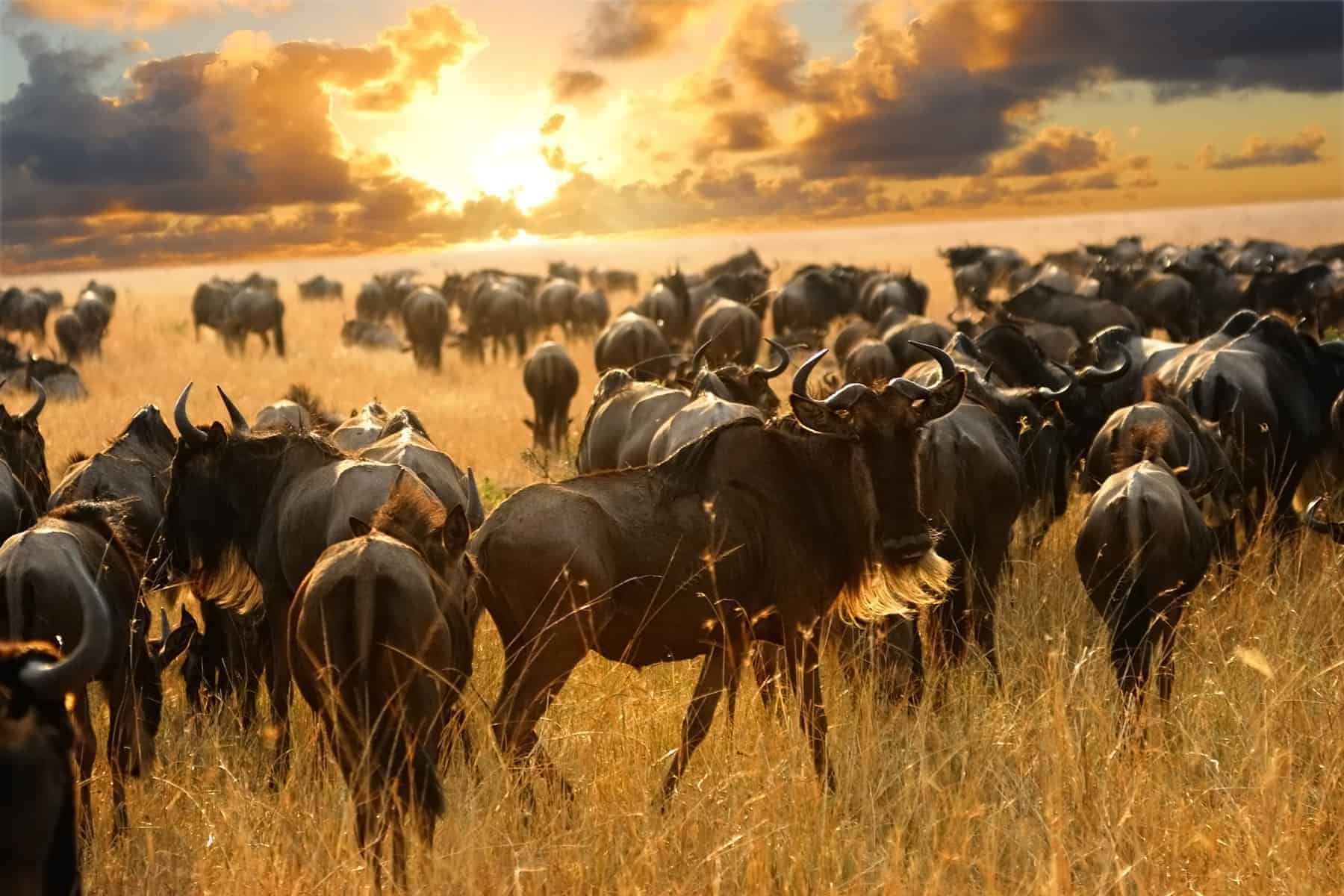
Great migration of antelopes wildebeest in the savannah, Masai Mara, Kenya
Masai Mara, Kenya
Imagine a safari destination and the chances of it being this one, if only because many TV documentaries have made Kenya a bustling savannah, flat-top acacias and iconic sluggish predators on the continent.
The Masai Mara is a northern extension of the Serengeti in Tanzania, and the huge herds of wildebeest and other grazers that arrive from July to October similarly dominate the park’s ecology. This breathtaking spectacle is a magnet for predators; There is no better place to raise lion and cheetah in record time, helped by the open terrain and the ease of cats around the vehicles. Other drawcards include elephant, giraffe, and rare black rhinos.
The downside of the Mara is its popularity, which sometimes leads to intrusive clusters of minibusses. For a more exclusive experience, head to upscale camps in the west.
When to go: Cooler and more accessible during the dry season, from May to October.
What to see and do on your vacation to Kenya
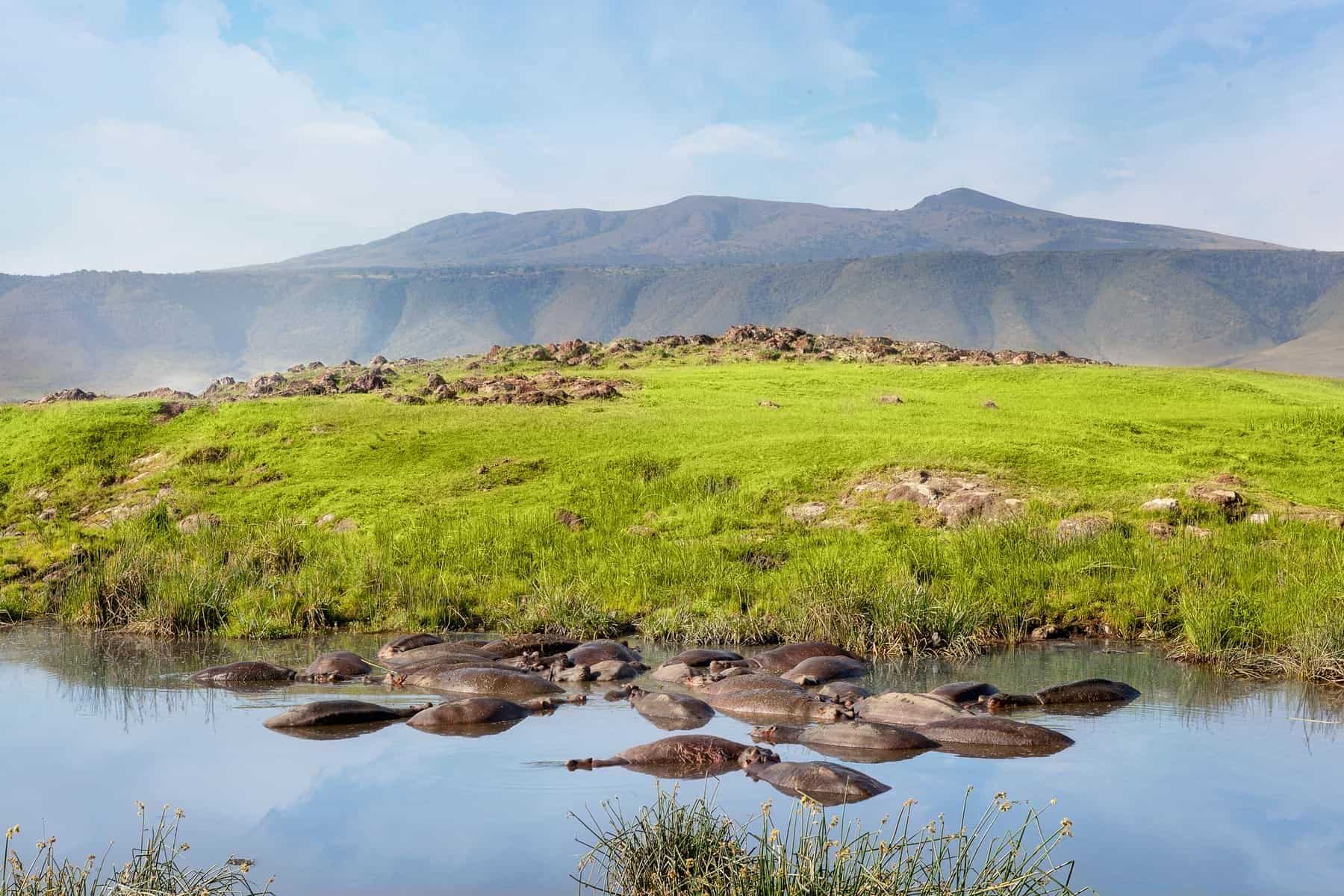
Hippo pool in Serengeti national park. Savanna and safari.
African safari at its most classic level: Serengeti National Park and Ngorongoro Crater, Tanzania
Serengeti National Park is located in northern Tanzania and shares a border with the Masai Mara National Reserve in Kenya. Its vast meadows offer classic safari panoramas dotted with isolated acacia trees and herds of zebras and antelopes. These herbivores attract a large number of predators, and the open environment makes it one of the best destinations for observing lions and cheetahs in action. The Serengeti is much larger than the Maasai Mara and, as such, often feels less crowded. From November to June, the Serengeti is the main stage of the great dramatic migration. At this time, huge herds of zebras and wildebeests gather to graze, mate, and give birth.
The Ngorongoro Conservation Area in Tanzania is made unique by its volcanic crater – the largest undrained and unbroken caldera in the world. This large depression acts as a natural enclosure for countless wildlife species, including the Big Five. Highlights range from a healthy population of black rhinos to some of the continent’s largest tusker elephants. The lake in the center of the crater also hosts huge groups of flamingos, while the Maasai still live in the conservation area. Another must-see attraction is the Olduvai Gorge, an important paleoanthropological site that has contributed immensely to our understanding of human evolution.
When to go: All year long; migration moves with the seasons; the best conditions June-October.
- Also see our personal account from Ngorongoro, hunting the big 5
- Read more about Serengeti National Park
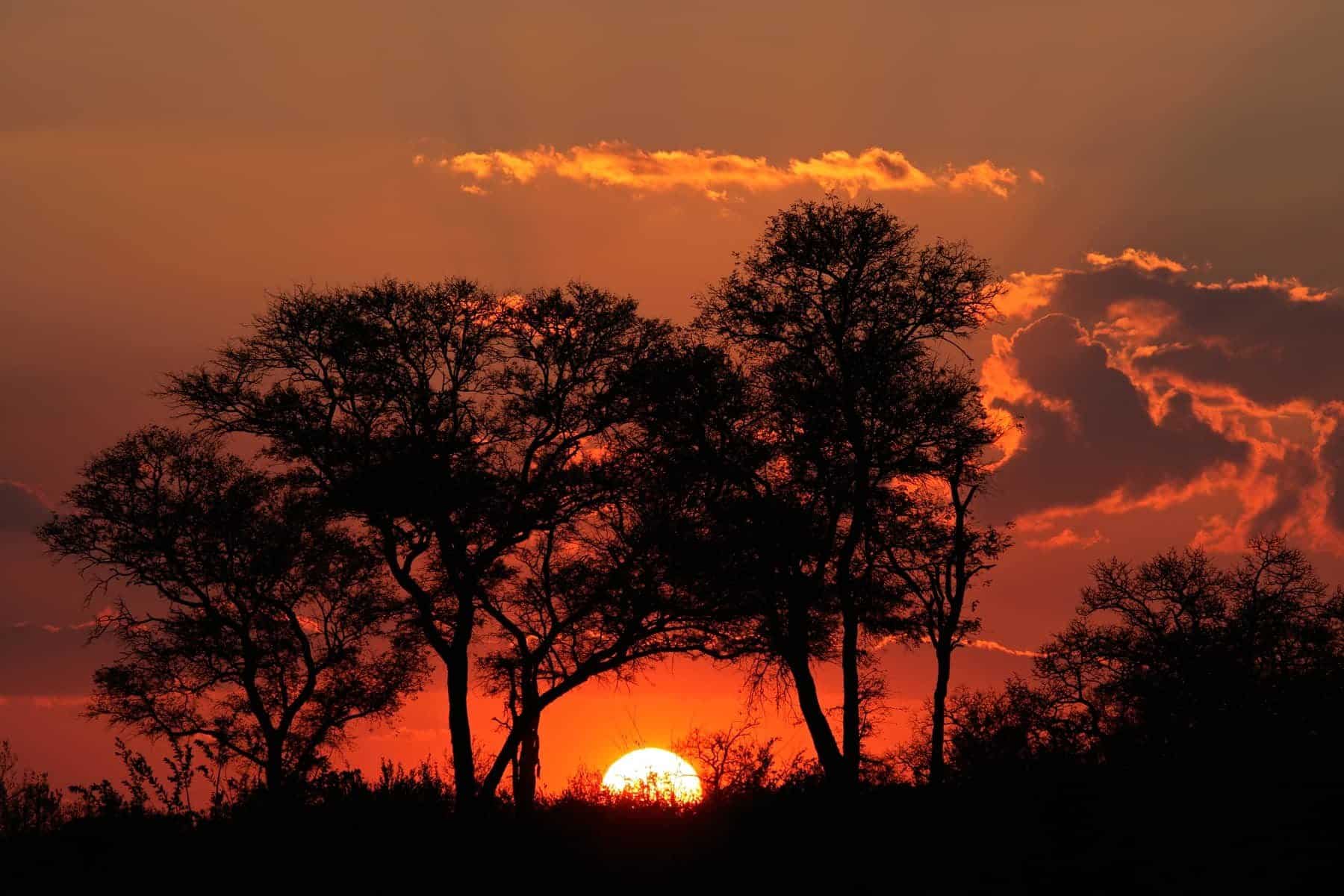
Sunset with silhouetted African savanna trees, Kruger National park, South Africa
African safari in Kruger National Park, South Africa
Located in the northeast of the country, on the border with Mozambique, the Kruger National Park is the most famous of the many game reserves of South Africa. In addition to the Big Five, the park is home to the vulnerable cheetah, the endangered wild dog and several species of elusive cats. This is a good option for new visitors to Africa, with a wide choice of accommodation options (from basic campsites to luxury lodges). With its well-maintained road network and easy navigation, Kruger is also the ideal safari destination. Ornithologists should plan a visit between October and March. At present, the park is home to more than 200 species of migratory birds.
When to go: All year long; main rain November-May.
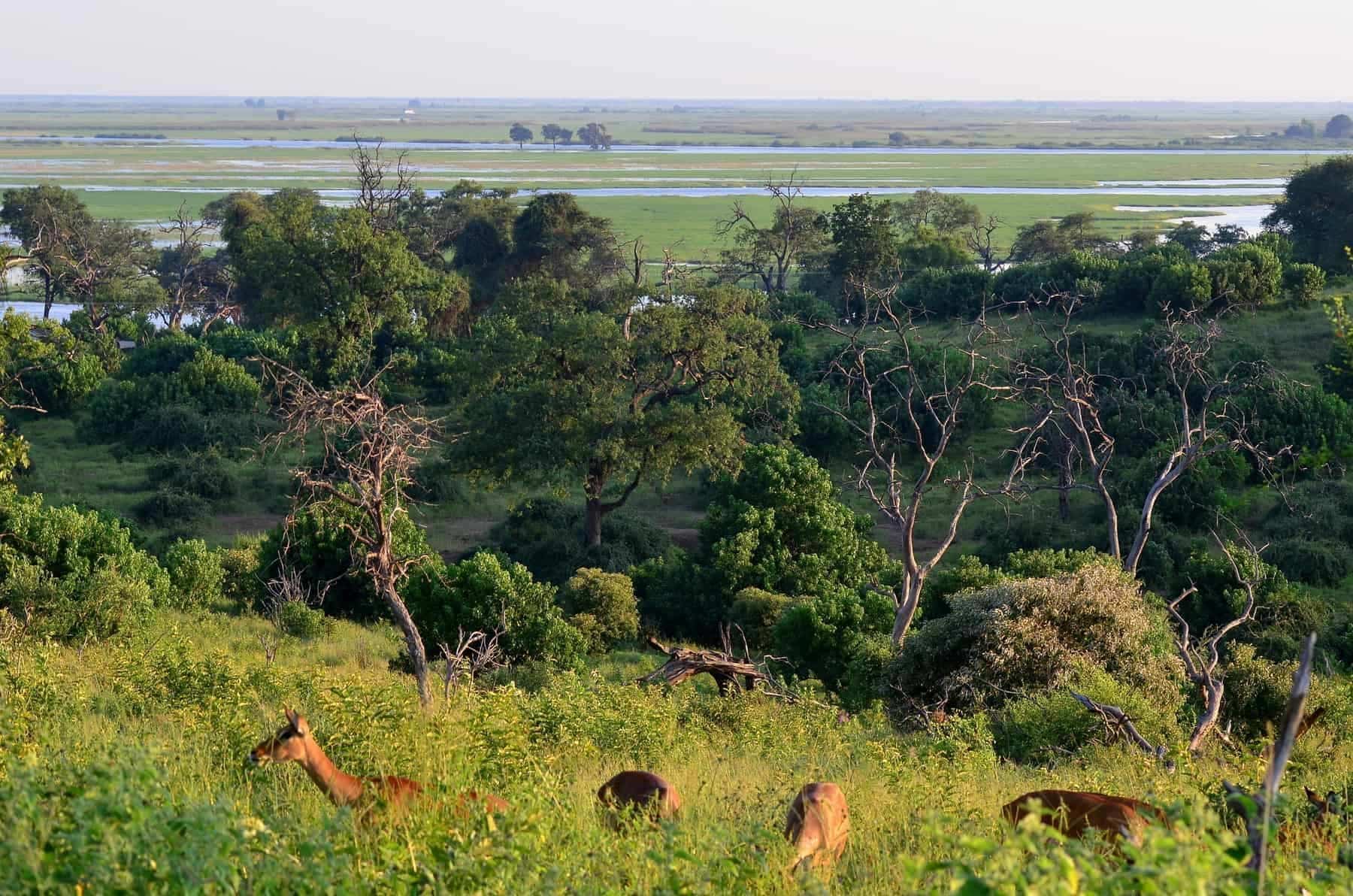
Chobe National Park, Botswana
Chobe National Park and Moremi Game Reserve in Botswana
Botswana is an arid land but, paradoxically, some of its best game views are on the water. In the dry season, wildlife invades the shores north of Chobe National Park, where boat cruises pass countless elephants and buffaloes. Lions and hyenas roam the roads, while sable is one of many herbivores. Victoria Falls is just only a day drive away.
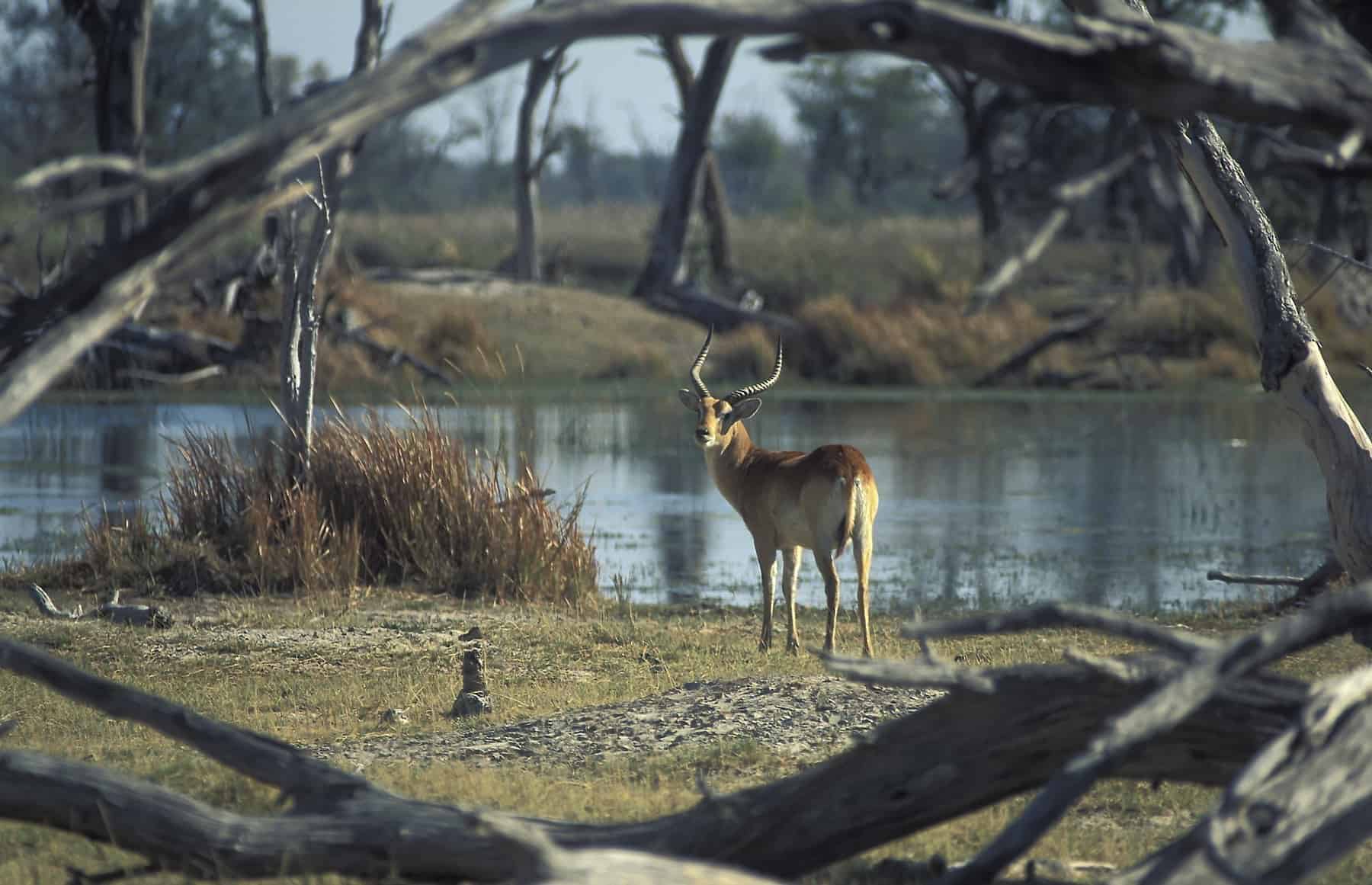
Red lechwe. Moremi Game Reserve, Okavango Delta, Botswana.
Further south, the Moremi Reserve protects the eastern fringes of the Okavango Delta, where seasonal streams attract much game from the rich surrounding mopane forests. Predators, including the wild dog, are abundant. Boat cruises through the lagoons or mokoro (canoe) trip along the narrow canals provide an abundance of game and birds.
These two destinations are often combined, making an air or road transfer, the latter passing through Savuti, famous for its elephants, lions, and hyenas. Both can be crowded in high season. Autonomous driving is reserved for experienced people, but there are mobile packages with a budget (using government campsites), as well as many pavilions.
When to go: June-October (maximum Okavango floods from May to August)
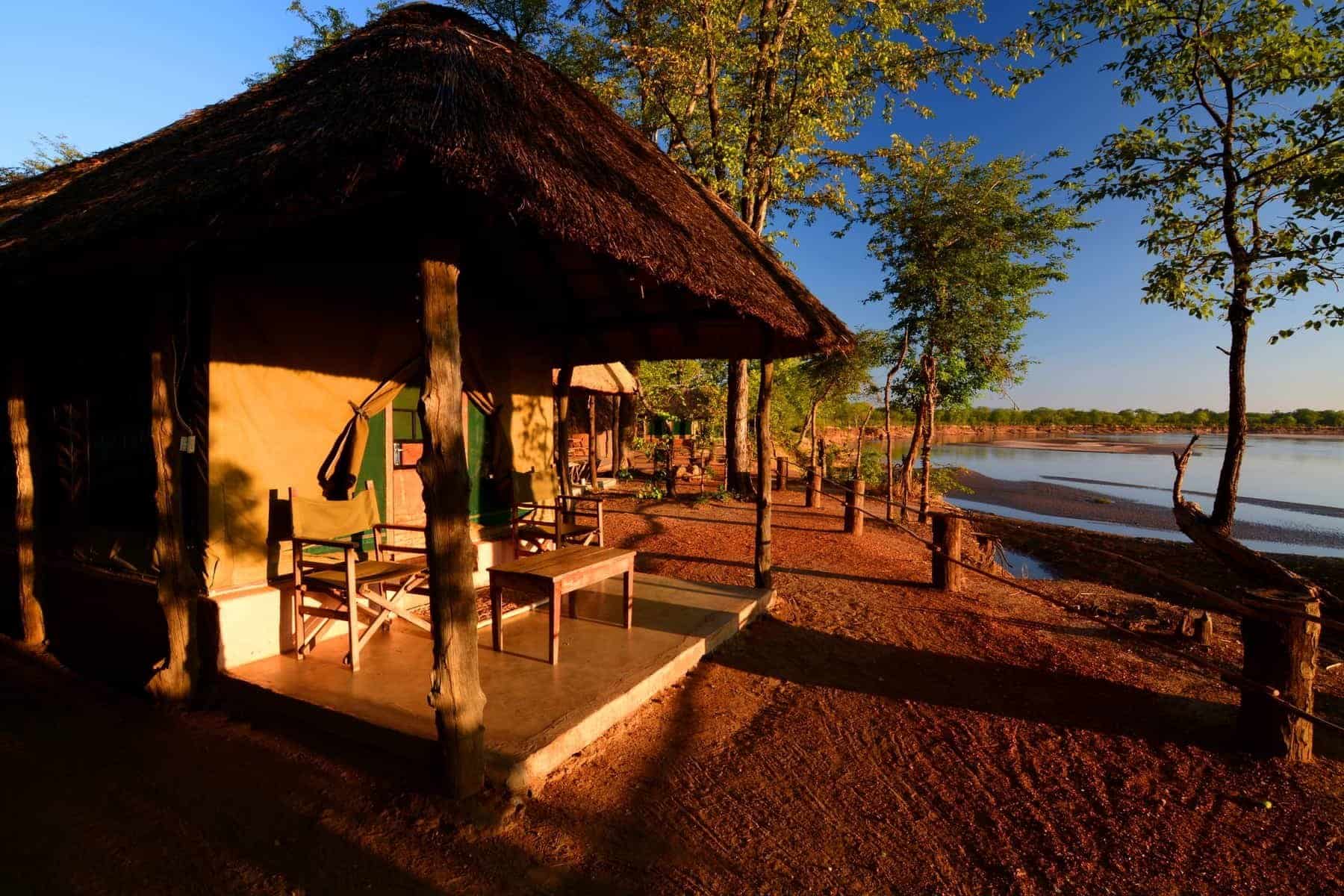
South Luangwa National Park in eastern Zambia, the southernmost of three national parks in the valley of the Luangwa River, is a world-renowned wildlife haven
African Safari in South Luangwa National Park, Zambia
The largest park in Zambia is generally considered a destination for the most discerning, thanks to its specialized guides and small, owner-run pavilions that promote a complete bush experience. Nevertheless, South Luangwa is also a favorite place for beginners. Towards the end of the dry season, the game is concentrated in large numbers around the contracting river and its hippo lagoons, and, with the exception of the rhinoceros and cheetah, you can expect to observe a wide range of wild animals easily. Night walks can track big cats on the lookout – there’s no better park for leopards – while guided walks offer a captivating glimpse of ground level in the bush. Indeed, this park is known as the safari house on foot.
South Luangwa is a robust destination for the independent traveler – There are more upscale lodge in the territory. But you can expect an excellent safari for your money, with exceptional wildlife, attention to detail and wild charm.
When to go: Viewing the peak game between June and October; floods during the rains (November-March), at the closure of some camps
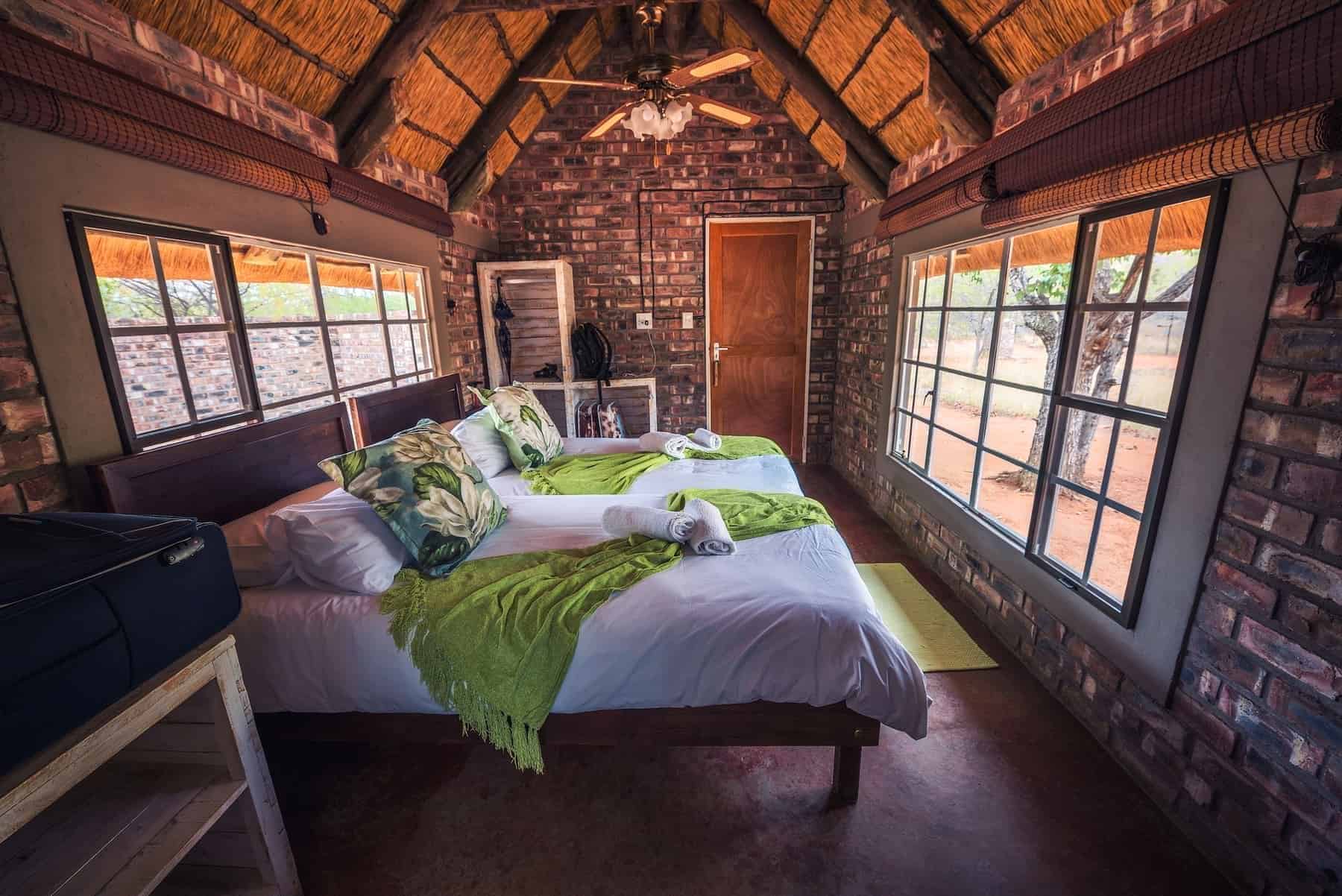
Chalet interior of the Kaoko Bush Lodge in Kamanjab. This desert lodge is located near the Galton Gate of Etosha National Park.
African safari in Etosha National Park, Namibia
Etosha is the Kruger of Namibia, with roads and facilities suitable for the economical safari by car. The rough, semi-arid terrain is not to everyone’s taste, with its thorny scrub, its calcrete debris, and its vast shimmering salt basin. And without rivers, you can forget about hippos and fangs.
The best stratagem here is to stake one of the many water points in the park and wait for the arrival of the animals. The end of the dry season draws a thirsty game procession from the arid bush. Zebra, giraffe, oryx, and others fight over the best positions, giving way to herds of elephants and black rhinos. The pride of the lion hides to ambush any stray.
Each public camp overlooks a busy water hole lit up at night. The rainy season brings lush growth and flamingos flock to the temporary lagoons. A number of private concessions in the southern and western parts of the park offer more high-quality guided safaris.
When to go: Viewing the peak game between June and November; pots flood January-March
African safari for second-timers
With the big game at your fingertips, these safaris take you away from the crowd to relax and enjoy a greater appreciation of wildlife.
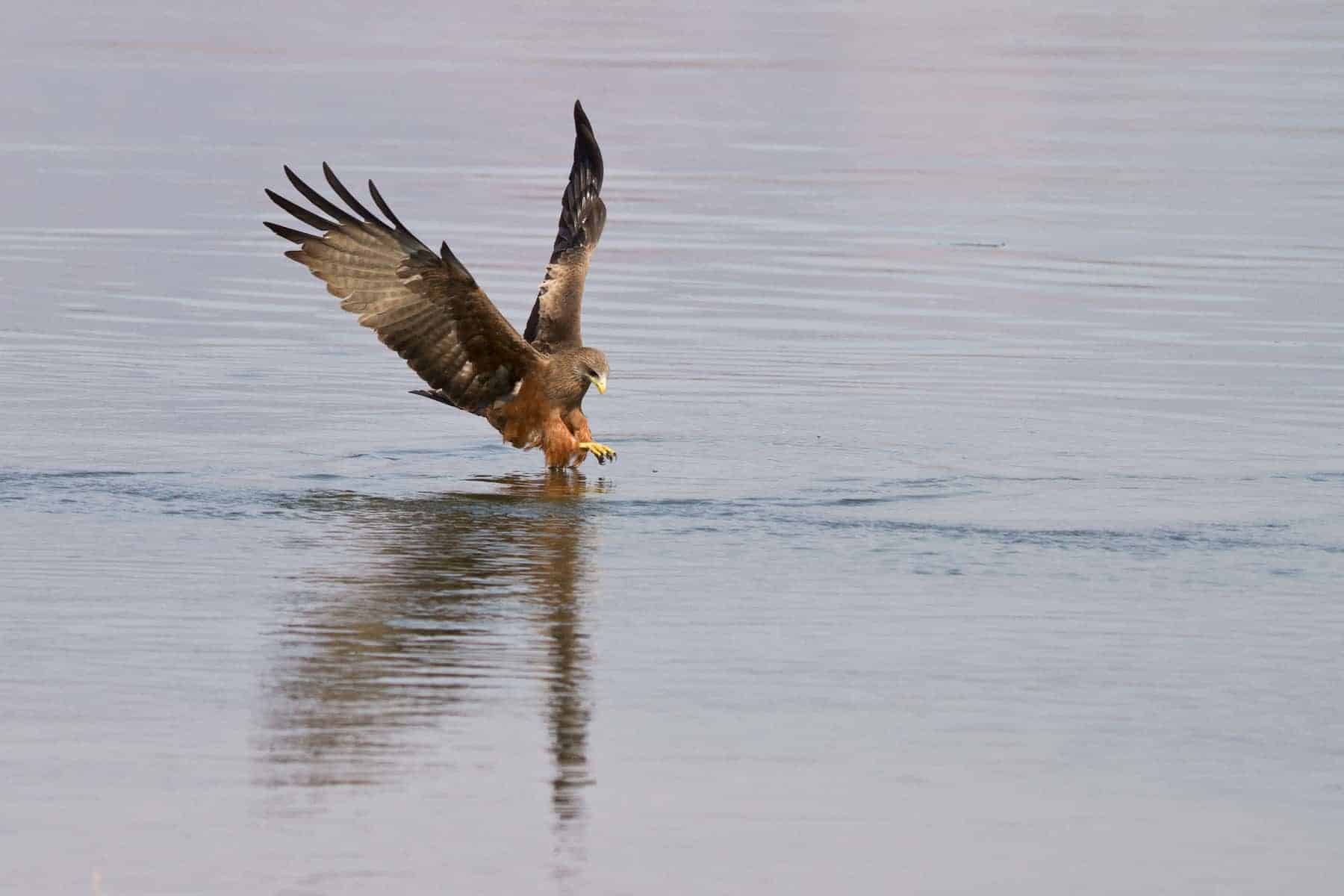
Zambia, Mana Pools, Black kite fishing
Mana Pools and Lower Zambezi National Park, Zimbabwe/Zambia
The Zambezi River winds from the east to the Indian Ocean across a vast floodplain between imposing escarpment walls. As the dry season approaches, the mosaic of islands, oxen and river terraces of the valley fills with wildlife: large herds of elephants and buffaloes descend from the hills, while lions and other predators are walking along the river.
This panorama of picture books straddles two countries: on the side of Zambia (north), it forms the Lower Zambezi National Park; on the Zimbabwe side, it is part of the Mana Pools World Heritage Site.
Absentees include rhinos, wildebeest, and giraffe – but this place is more about quality than quantity. The picturesque backdrop simply invites you to sit down and immerse yourself in all of this – which is not a bad strategy when wildlife flocks at will in the riverside pavilions.
Access by road is difficult, and the emphasis is on the high-end, especially on the Zambian side. Activities include safaris and bush walks. It is one of the main boating destinations in Africa: wildlife borders the shores and hippopotamuses hide at every turn. The wilderness trails of Mana Pools are for adventurers.
When to go: Watch the game from May to October; no road access to Mana Pools during the rains (November-April), when many Zambian camps also close.

African safari. Female leopard waits quiet over a hill looking for her pray in Pom-Pom Island private game reserve, Okavango delta.
Okavango Private Reserves, Botswana and the big 5
If a trip to Moremi has opened the appetite for the Okavango, a number of private concessions offer a more exclusive window on this fabulous wildlife area. Each has its own attractions depending on the terrain, some more aquatic than others. The reintroduction of white and black rhinos means that the region now claims the full Big Five, while the best is the observation of Africa’s wild dog and dramatic lion/buffalo interactions.
Access is almost entirely by air, and many pavilions are extremely chic, with prices high. Your money gives you fabulous places, high-level guides, beautiful wilderness, and a chance to enjoy activities such as walks, night tours and even elephant safaris, which are not available at inside the national park.
When to go: All year long; View of the peak game July-October.
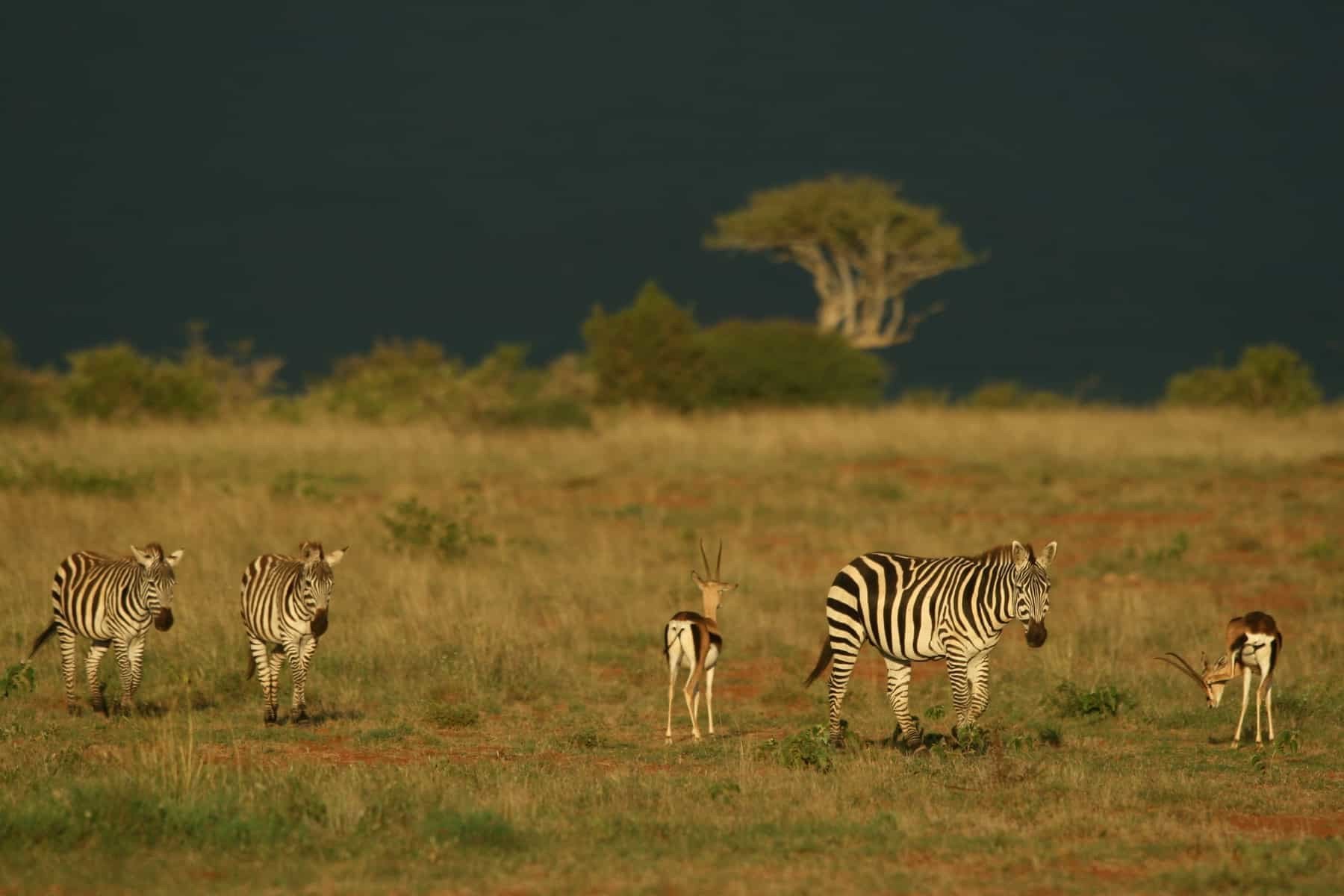
African safari. Plains zebra and Grant’s gazelle, Laikipia, Kenya
Laikipia Plateau, Kenya
The Laikipia Plateau is located on the southern edge of Kenya’s northern border and offers spectacular views of snow-capped Mount Kenya to the south. With wildlife similar to neighboring Meru, Samburu and Buffalo Springs, it includes a dozen private concessions, including the Lewa Wildlife Conservancy, which have joined forces in a huge conservation initiative. This protects one of Kenya’s healthiest wildlife populations, with elephants, buffaloes and all significant predators, as well as reticulated giraffes, Grevy’s zebra and more than half of the country’s black rhinos.
Laikipia offers an exclusive alternative to Kenya to Masai Mara; the lodges – some very imaginative – tempt guests with everything from trekking on camels to fishing. It has become a pioneering area for ecotourism, with many properties belonging to the local community. High altitude means that large areas are free of malaria and generally cooler than Mara.
When to go: All year long; some lodges close with “long rains” (November-March)
What to see and do on your vacation to Kenya
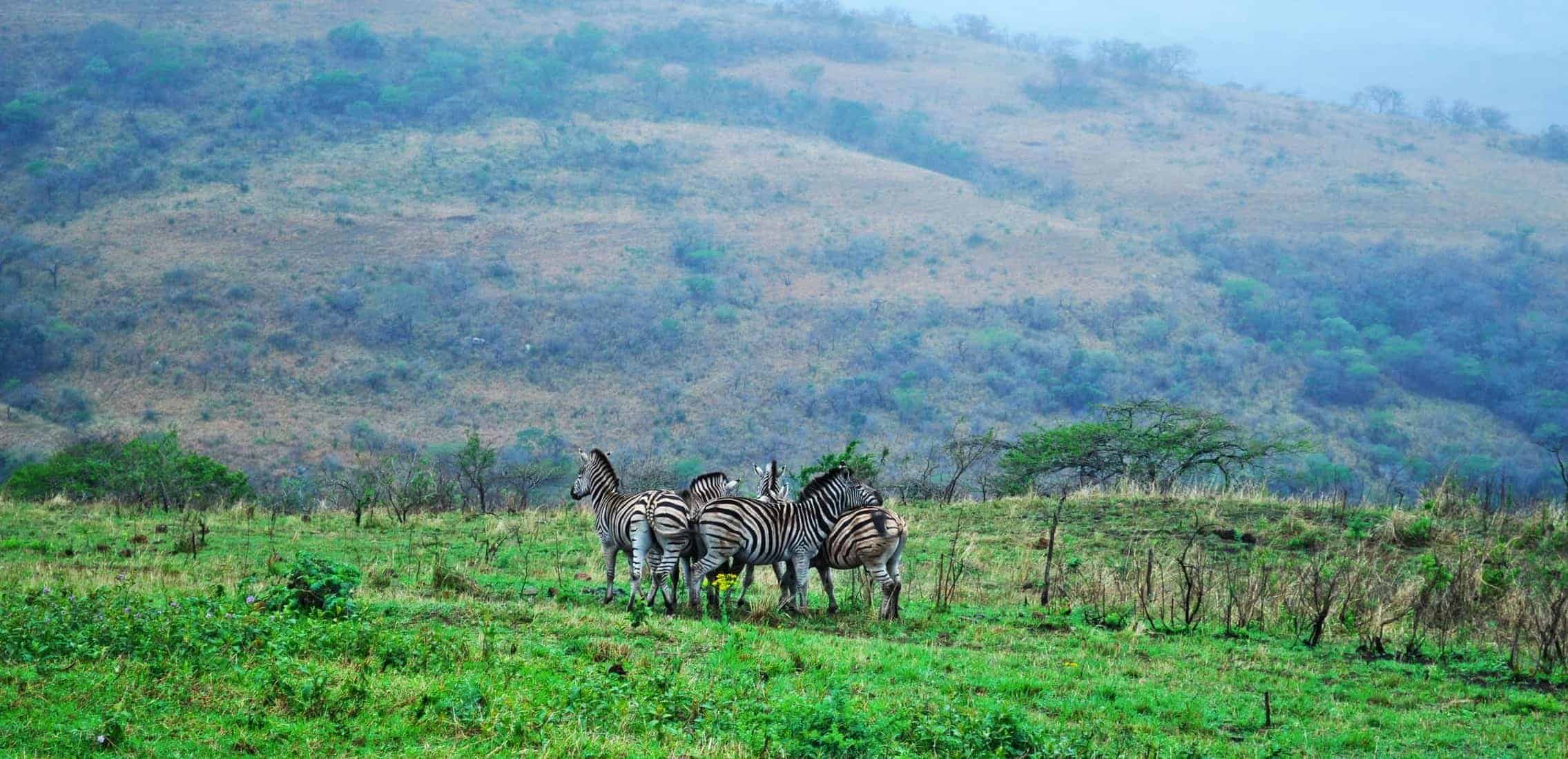
African safari. Safari in South Africa, 28/09/2009: a herd of zebras in the Hluhluwe Imfolozi Game Reserve, the oldest nature reserve established in Africa, in 1895, located in KwaZulu-Natal, the land of the Zulus
Imfolozi Wilderness Trails, South Africa
Imfolozi is synonymous with white rhinos and wild tracks. This is where Africa’s second-largest land mammal fought extinction a century ago. This is where the curator Ian Player developed his concept of wild tracks, encouraging a more holistic appreciation of nature.
Close encounters with white rhinos are common when you cross the rippling bush. The black rhino also thrives, while elephant, buffalo and all major predators are present. But the trails consist as much to appreciate the tracks, the singing of the birds, the insects and the plants as the sensations of the big game. The camping is basic, the guides exceptional and the total immersion in nature memorable. The park is easily accessible by good roads and trails are offered at great prices from the KwaZulu-Natal Parks Council.
Reserve your spot in advance.
When to go: The trails (2, 3 or 4 days) are from mid-February to mid-November.
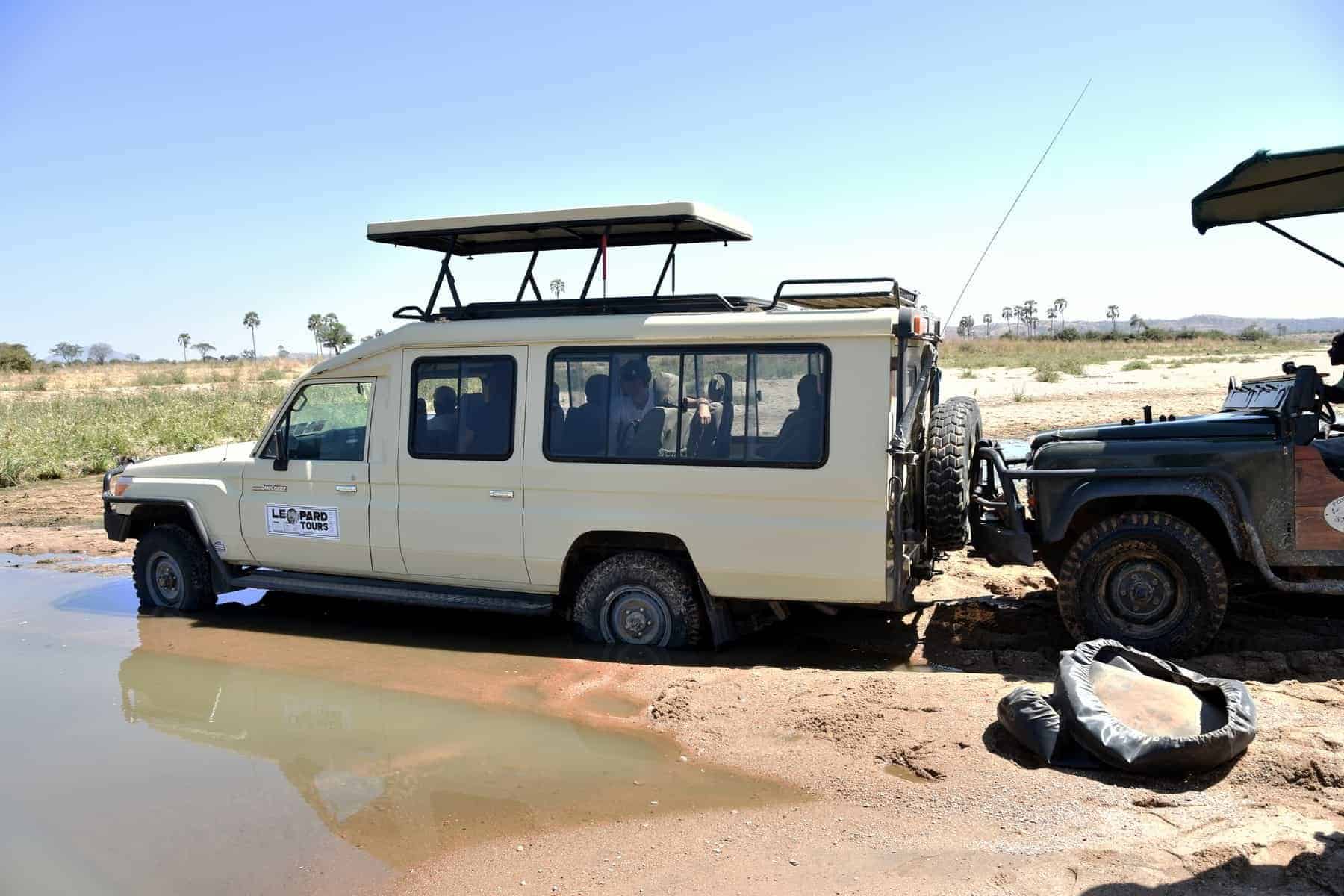
African safari. Ruaha National Park, Tanzania, Africa – a safari car is stuck in the river while another car is trying to push it out, Ruaha National park, Tanzania.
Ruaha National Park. African Safari in Southern Tanzania
As the “southern circuit” of Tanzania has developed in recent years, this once-obscure park has become a favorite. It offers a big game classic in an isolated setting, with the few camps far from each other.
The attractions include the largest elephant population in Tanzania, as well as many buffaloes and the entire spectrum of large predators. Its geographical position between two biomes – the East African Acacia savanna and the miombo forest of Southern Africa – means an unusual mixture of species, including for example both the small and large kudu.
This reservation is often associated with a visit to Selous. The lodges are upscale, and access is usually by air. It is best to observe game during the dry season when large flocks congregate around rivers, although birdwatching is excellent during the rainy season. Activities include night tours and walks with expert guides.
When to go: All year long; some lodges close during “long rains” (November-March)
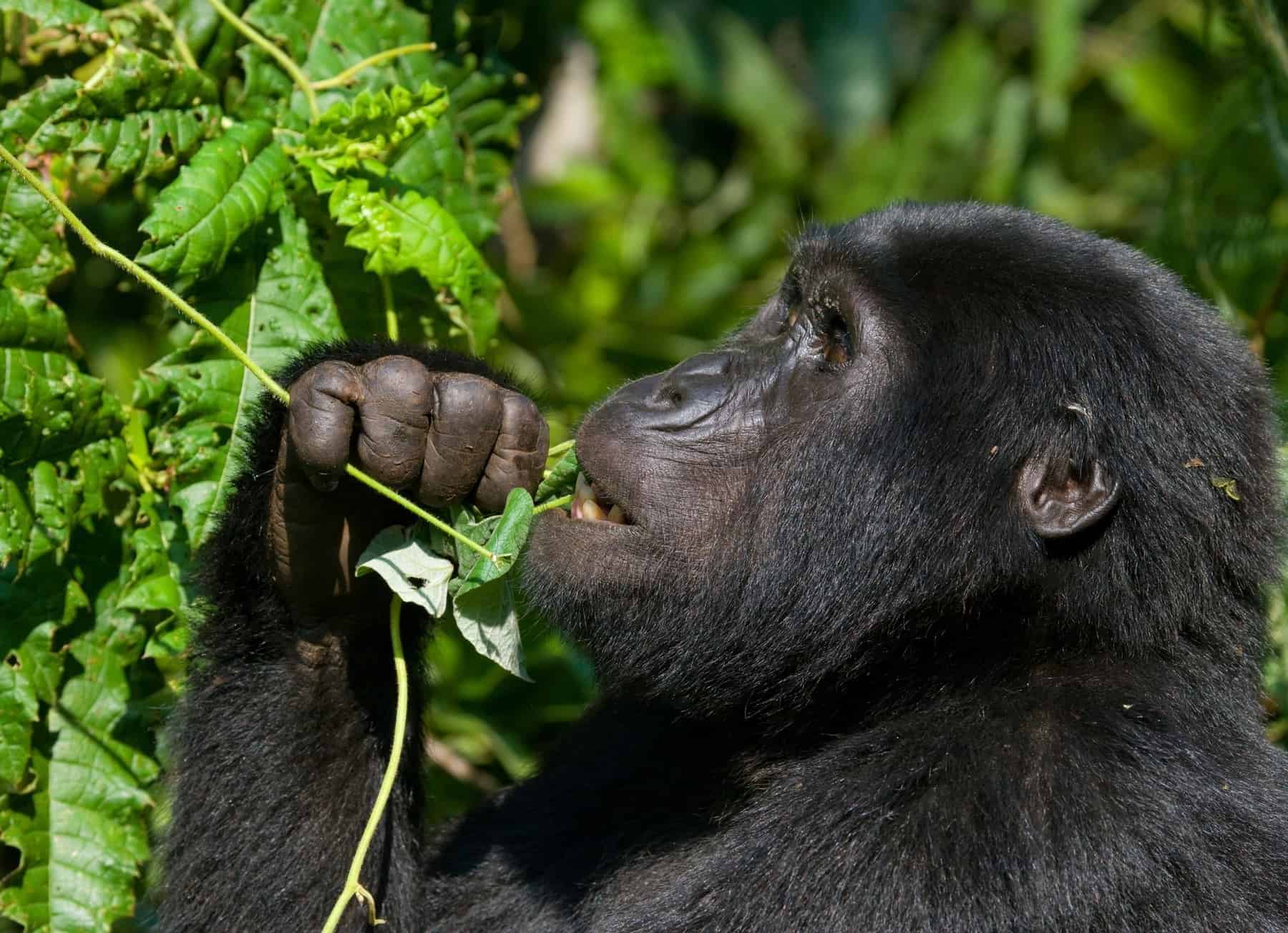
African safari. Mountain gorilla eating plants. Uganda. Bwindi Impenetrable Forest National Park. An excellent illustration.
Queen Elizabeth National Park, Uganda
Uganda is renowned for its gorilla trekking, and with Kenya and Tanzania hosting most safari visitors in East Africa, its wildlife parks are often neglected. While this park has suffered a lot from poaching in recent years of turmoil in the country, wildlife has returned at an astonishing rate.
Today, elephants and buffaloes roam the shores of the lake, while hippopotamuses invade the Kazinga Channel and lions in the Ishasha trees feed on abundant kob, waterbuck and other antelopes.
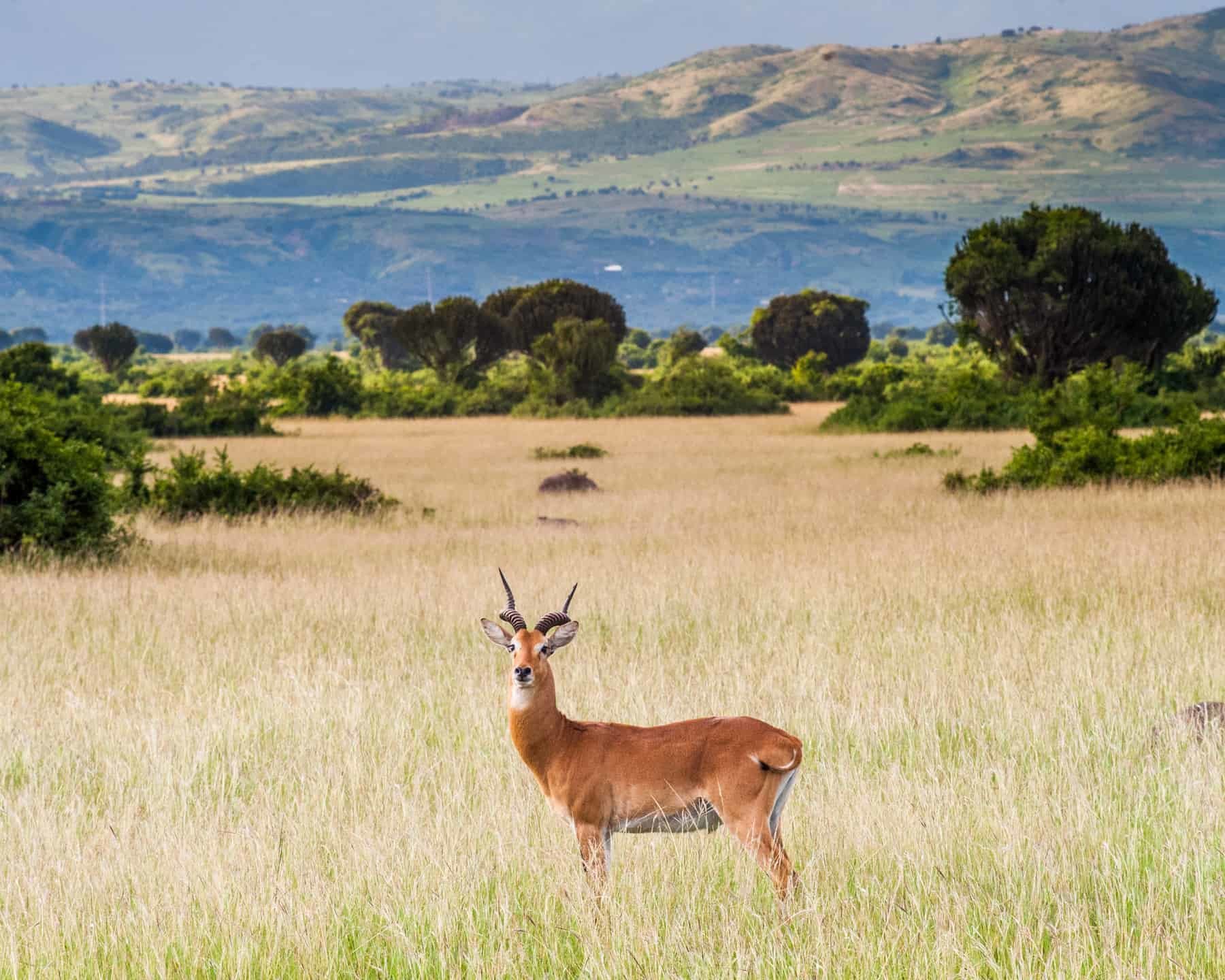
African safari. Queen Elizabeth Safari Park in Uganda, antelopes
Although beginners are guaranteed to catch big game, most experienced safari enthusiasts will find that the unusual variety of habitats, for a relatively small park, offers an impressive diversity. This goes to the chimpanzees in the wooded gorges and the threaten shoebill papyrus in the swamps. The bird list of 610 species is exceptional in every way. A full range of activities and accommodation is available, including boat cruises, all under the background of the Rwenzori Mountains.
When to go: The wettest months from April to May and from October to November, when some roads are impassable.
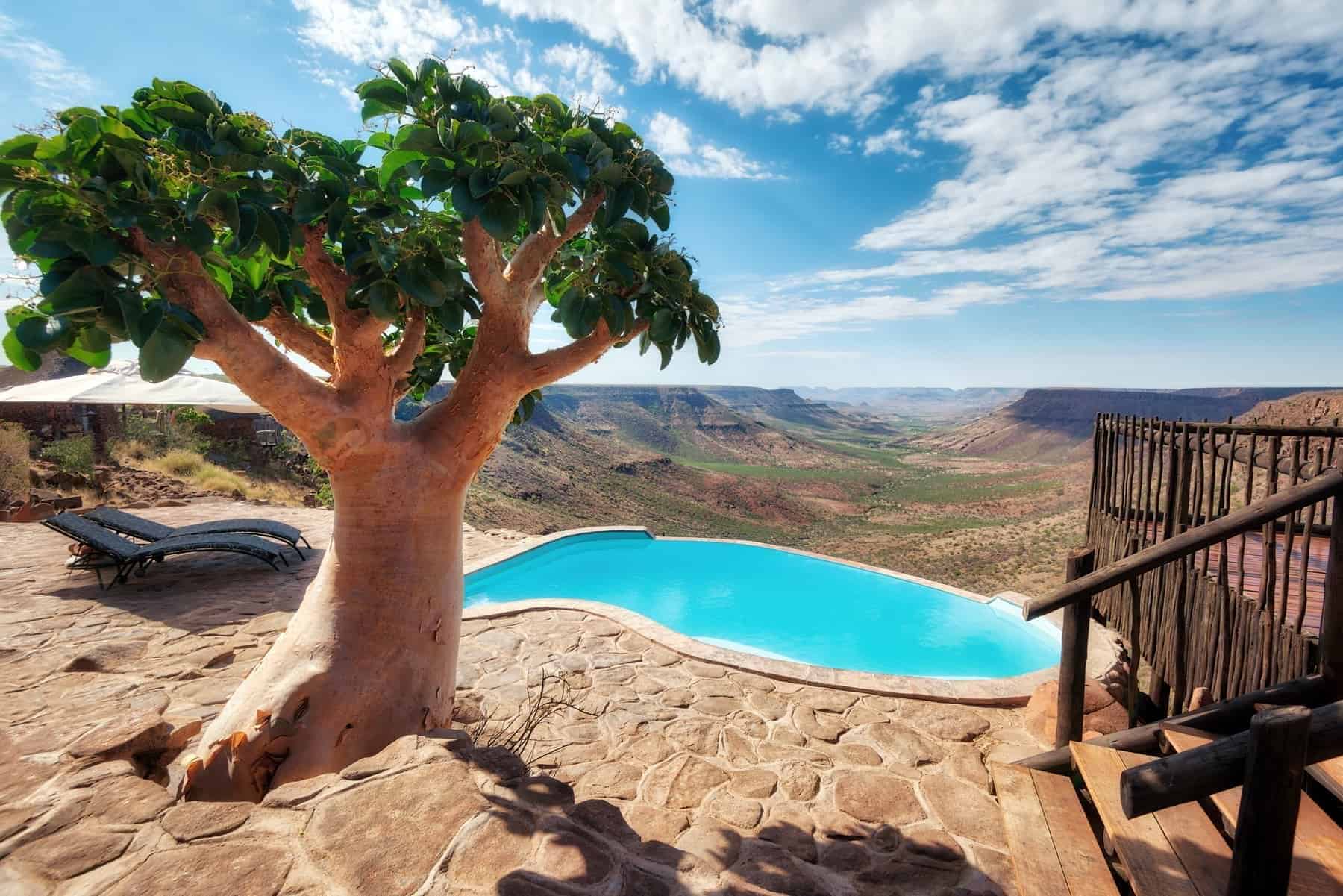
African safari.. Grootberg Canyon in Northern Namibia taken in January 2018
The best African safaris for connoisseurs
These safaris are for those who have recorded all the greatest hits and want to go even further, looking for unusual wildlife or a real experience in nature .
Northern Damaraland, Namibia
The hilly and semi-desert landscape of Damaraland, in northwestern Namibia, extends beyond any national park. It is a land where spectacular geology, ancient rock art, and unique flora and an array of exotic wildlife. Nevertheless, a good selection of game walks in stony plains and sandy areas, with the elephant and black rhinos particularly adapted to the desert.
The giraffe, oryx, mountain zebra and occasional predators, including cheetahs and rare brown hyenas, are also to be discovered.
A series of river valleys, usually dry, allows visitors to penetrate deep into the rugged terrain; several exclusive lodges offer safaris both on foot and 4×4. Expect to see an impressive dose of true wilderness, with the rare opportunity to hunt down a black rhinoceros and camp under the stars.
When to go: May-November (camps closed during the rains)
African safari in Katavi National Park, Tanzania
Most African parks tout themselves as the “ultimate wilderness” but Katavi National Park is hard to beat because it is so far off the beaten path – even by Tanzanian standards – that only a few hundred visitors access it each year. Its land is composed of mixed forests and two huge grassy plains, where flocks gather. The only permanent water sources are the Katuma and Kapapa rivers, which inflate with hippos during the dry season. Elephants are numerous, while lions follow the many buffaloes.
This park is for safari connoisseurs who want the bush entirely for themselves. Flights to this remote corner of western Tanzania are expensive, and the few small permanent camps in the park offer an intense and upscale wilderness experience. The distances are such that safaris often last the day. The walk is excellent, and it is possible to organize night camps with all the accompaniments.
When to go: Open all year; Best game from May to November
North Luangwa, Zambia
The ultimate safari thrill: meet face to face with a lion on foot. This isolated park has terrain similar to that of South Luangwa but a wilder feel and a fraction of the number of visitors.
The game is timid and the observations less reliable – the legacy of poaching from the past, but also because of the ignorance of wildlife with humans.
Large herds of buffalo attract a lion’s pride, while hyenas and leopards are abundant.
Only three small camps operate in the park, so you feel like you have room for you. Access is generally by air and activities are almost entirely on foot. High-level guides follow the wildlife and reveal the secrets of this pristine environment.
When to go: May-November (camps closed during the rains)
Central Kalahari Game Reserve, Botswana
The sandy grasslands and wooded areas of the Kalahari are an arid and challenging environment, where wildlife is very nomadic. This place is at its best at the beginning of the year – from January to May – when the rains give new growth and thousands of springboks, gemsboks, wildebeest, eland and others arrive at the pasture. Predators include cheetahs, both types of hyenas, and the famous Kalahari black mane lions. Meanwhile, a multitude of specialized residents range from ostriches to meerkats.
Until recently, access to this vast wilderness (over 50,000 km 2, the park dominates the Serengeti, Kruger and South Luangwa combined) was limited, and visitors could enter only on a mobile safari. Today, two permanent camps inside the park complement those outside. Game viewing can be uncertain at times, elephant, hippo, and buffalo, are absent. Nevertheless, the scale and isolation are impressive.
When to go: Best game from January to May, although access can be difficult then.
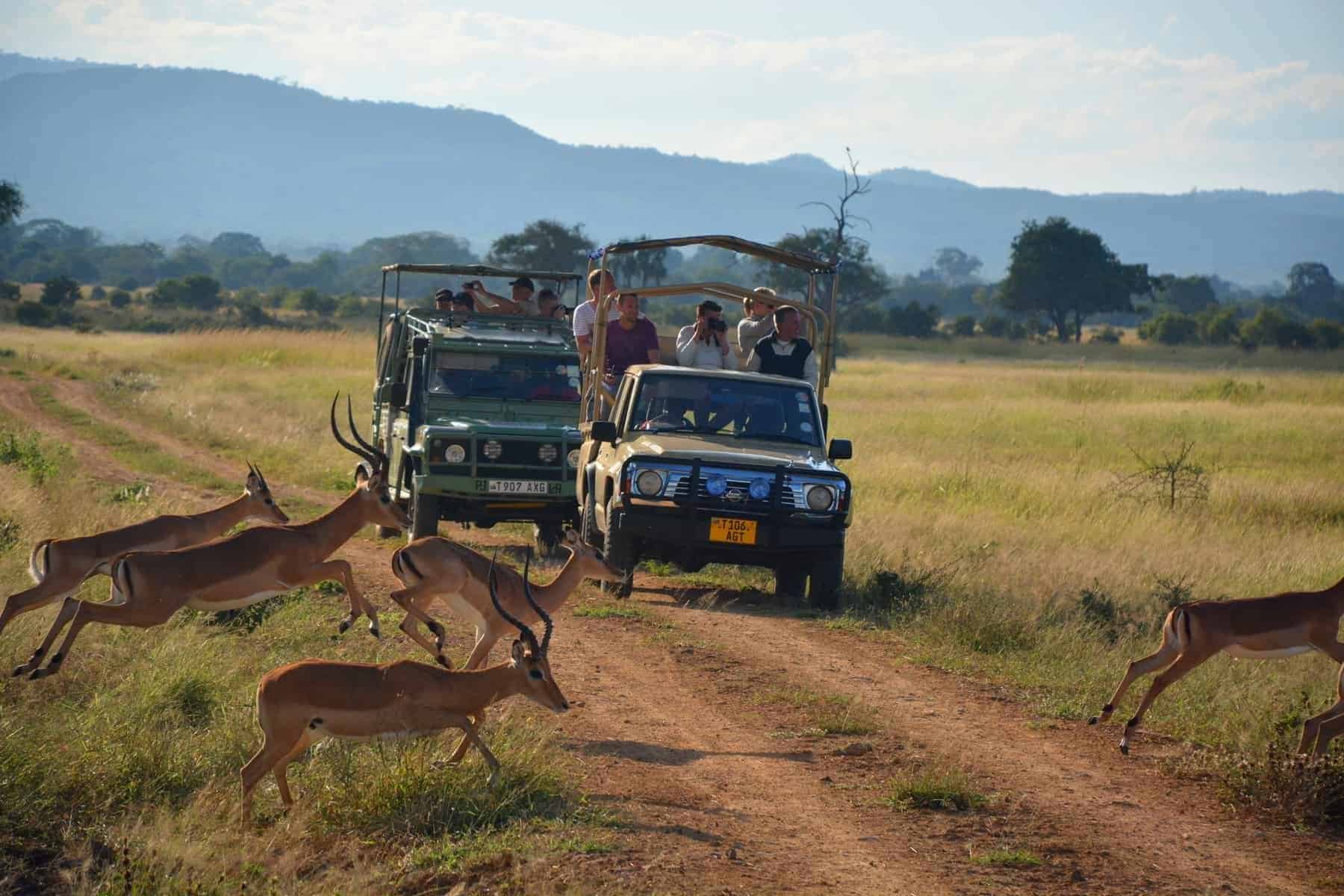
African safari. The Mikumi National Park is a national park in Mikumi, near Morogoro, Tanzania. The Mikumi is bordered to the south with the Selous Game Reserve, the two areas forming a unique ecosystem
South Selous Game Reserve, Tanzania
Less known than the Serengeti, Selous is the largest game reserve in Tanzania and the backbone of the South Circuit safari. Its land is distinct from the northern savannahs, with its woods, mountains, and riparian forest. The game is not as visible as in the Serengeti, but the number and variety are impressive, with large populations of elephants, buffalo, lions, and hippos, as well as local specialties such as sable and the wild dog.
The Rufiji River crosses the park and divides it in two. Most safaris are limited to the small northern sector, where a handful of upscale lodges offer a full range of activities, including boat trips on the Rufiji. These are serious adventures in pristine nature, with expert advice from former hunters, most of it on foot. The game can be capricious, and the routes are drawn on the hoof of the game, but you will not have a wild safari.
When to go: All year long.
Liuwa Plain, Zambia
This isolated savannah in the Barotseland district of western Zambia was once the hunting ground of the Litunga, king of the Lozi people. Today it is a national park, but so far from the safari circuit that it requires a serious expedition to get there. The few visitors who trek – by water and by road – find themselves alone in a vast plain of grass, punctuated only by scattered pools, palm groves and nibbling many blue wildebeest.
Wildebeest arrive with the rains to form more massive herds outside the Serengeti; their number climbs between November and June, they are joined by zebras and other grazers.
Hyenas are the dominant predators, with some wild dogs and wandering cheetahs and a small population of lions. But Liuwa is not a place to play big game. Its flora and birds are as special as its mammals and, better still, it offers adventure, isolation and unknown.
When to go: May/June and November/December
African safari FAQ
Whether you volunteer for wildlife and avoiding malaria, all your burning safari questions will be answered here:
When is the best time of year for a safari?
If you just like to play big game, conventional wisdom favors the end of the dry season, when wildlife comes to the water hole, and the sparse vegetation improves visibility. When the rain falls, the bush breaks into leaves, the herds disperse, and some places become inaccessible.
But the rainy season also brings baby mammals, a better bird life, a beautiful sky, and fewer tourists. The rains in southern Africa last from November-March; in East Africa, the pattern is more complex.
Check local Safari travel factors
Luangwa Valley, some lodges offer excellent “emerald season” safaris during the rains; Kalahari wildlife is preferable immediately after rains; Kruger’s all-weather roads mean there is no bad time to leave.
What should I bring with me on safari?
Light, breathable clothing with sleeves and pants (to protect against insects after dark) will work, as well as sneakers, a hat and something warm for evenings. If you love to trek, neutral colors are essential – animals spot anything that is white or colored.
Camera or not, you will need binoculars: the view can be remote, and the avian life of Africa will soon turn non-observers into ardent observers. Also, carry a torch to move around the camp and observe wildlife after dark; spare batteries because charging is often impossible; and field guides (especially birds) because, even with experts, it’s a pleasure to check.
What about health – especially malaria?
Anyone traveling to sub-Saharan Africa should take the usual health precautions. Malaria deserves special mention, however. Talk to your doctor about the best prophylaxis for you and your planned safari destination – and do not forget to take the drugs, be sure to finish the medication journey back home. Also, cover and use an insect repellent after dark.
The risk varies according to the place and the season. In some areas, such as Namibia’s Damaraland (too dry) and Malawi’s Nyika Plateau (too high), malaria is rare – but you will probably go through a malaria-affected area to get there. South Africa offers the only guaranteed safaris without malaria, especially in eastern and northern Cape.
Are the savannah animals dangerous?
As a tourist, the dangers are negligible, as long as you do as you are told. If you are in a vehicle, most animals will ignore you: you can sit in a jeep open a few meters from the pride of the lions, and they will hardly record your presence (although you still want to leave elephants a lot of space). On foot, your guide will avoid risky situations and, in reality, most animals will avoid you. In a canoe, the protocol with hippopotamuses will be explained to you.
Never feed or encourage any wild animal: the most dangerous are probably those who feed in crowded camps, such as baboons, who have lost their fear of humans. And it is better to assume that all waters contain crocodiles. Just to make sure.
Will I be stuck in a vehicle all day?
For an outdoor activity, safaris can be surprisingly sedentary. And with the amount of food you’re likely to consume, especially in a lodge, the more active ones can be frustrated by the lack of exercise. Self-drive tourists should be allowed to keep a reasonable distance and spend time stretching their legs in camps and picnic sites. Consider packages that offer rides – or try a complete walk safari where you will spend most of your time. Canoeing, horse riding, and mountain biking are other activities that are active. Safe gambling-free areas, such as the Nyika Plateau in Malawi, tend to offer more. Try Victoria Falls or Namibia for adventure sports.
Where are the best safari guides and how to find them?
A great guide can turn your safari into a life-changing experience. The Zambian guides, especially in Luangwa and Lower Zambezi, have an excellent reputation, the fruit of a rigorous training system. Similar high standards are associated with northern Botswana, Namibia, and Tanzania.
Overall, the best guides can be found at private lodges, where they live on-site, and their knowledge of the terrain and wildlife is second to none. Guides on budget packages can be good and helpful, but most times do not have the same level of knowledge and expertise. Only the elite guards are trusted with walking safaris, and these include those leading the Kruger Park and Imfolozi wilderness trails
Do I really need a guide on my safari?
Guides, despite their knowledge and expertise, are not indispensable. There is much to be gain by doing things your way. You may not be able to find as many wild animals, but you will find it easily. You can also follow your own agenda, without compromising the good of the group.
Parks with good infrastructures, such as Kruger, Etosha, and Hwange, make life easier for the do-it-yourselfer: you can follow the map, look at observation boards, and exchange news with other visitors. Doing what you want in the wilds of Okavango or Serengeti, for example, is only for seriously equipped and experienced people.
How to choose a good tour operator?
Shop – not just for the price. The best operators should offer a counselor who knows the destination and can answer your questions based on personal knowledge and experience. They must honestly emphasize the pros and cons of not going out, clearly indicating the “extras” (park fees, activities, etc.) and explaining how much time you spend on each place, not just on the road. Beware of wildlife “guarantees”: for peace of mind, your British operator must be a member of ABTA or AITO and protected by ATOL.
How can I engage responsibly in a safari?
A good operator will clearly outline its tourism policy in their brochure or website. Learn about animal welfare and conservation guidelines, carbon offsets systems, and lodges. Ask for how sustainable is their resources
Lastly You, what is your role?
Your own behavior makes the difference, whether on a package tour or independently. Never feed or harass wild animals. Observe speed limits and take out the garbage when camping in remote areas. Learn more about the local community – and if there is a project you can contribute to, you may well consider it. Small contributions may make a big difference. All up to you. Safaris are an eye-opener in so many ways.
Book South Africa tours with top travel agencies with best competitive prices
Garden Route & Addo Group Adventure – 6 Days
5 day Best of South Africa’s Garden Route & Addo Adventure Tour
Explore Cape Town & Kruger National Park National Geographic Journeys
African travel
- Travel Africa, intro to major African vacation destinations
- Seychelles, Indian Ocean
- Mauritius
- 10 curated travel adventures in Africa
- Travel Agencies world-wide for your best vacation
- Ngorongoro in Tanzania offers the sight of all the big 5 safari animals
https://vacationtalks.com/mauritius/




